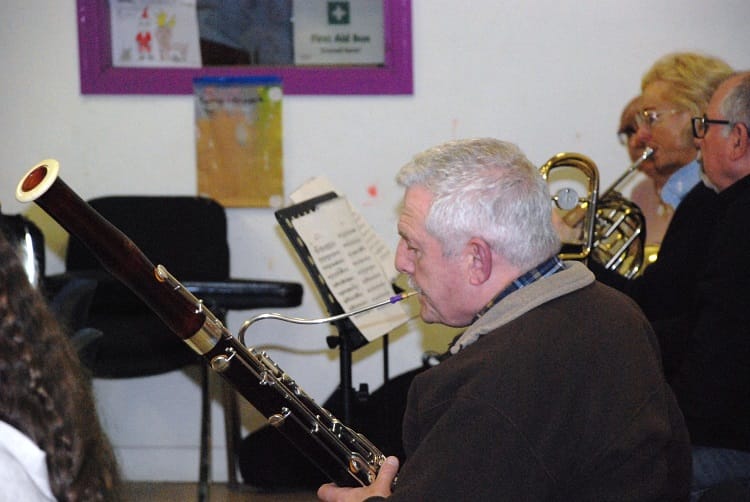What would become of the Civic Offices on Wood Quay if the council relocates?
After The Currency reported the idea of the council moving its HQ, councillors were talking about and thinking through the pros and cons and implications.
Last year, Ian and Louise Ó Maonaigh cobbled together an orchestra for a charity performance. And then they did another one. The next is in December.

Ian and Louise Ó Maonaigh have only just found their bassoonist.
He took his place at the back of the playschool on Sunday evening, as those around him – with violins and cellos, oboes and flutes – tuned and warmed up their instruments.
Last year, Ian and Louise, who are brother and sister, decided they wanted to form a local orchestra.
They roped in some Drumcondra locals, players from 15 to 80 years old, keen to explore new music and crack open their instrument cases.
Two concerts later, between adagios and allegros, the Humanitarian Symphony Orchestra (HSO) as they called it, is still growing.

“We pulled people from everywhere for that,” says Ian, burly and dressed in black. “So we decided to keep it up, in a moment of madness.”
“That” was the HSO’s debut last year in Christ Church Cathedral.
In response to the refugee crisis, the Ó Maonaighs had cobbled together the orchestra for a performance. The gig went well. They pressed ahead.
“It was nerve-wracking stuff,” says Ian. “We’d people coming in wanting to do whatever, all that sort of stuff, so you’ve to manage it.”
An orchestra, he says, is usually disciplined, practiced, and polished.
This evening, around 20 musicians strike up the first notes inside the Arts and Business Campus on the Lower Drumcondra Road.
By day, the room they are in is a playschool. On the wall to the right is an animal-themed “Birthdays Are Fun” calendar. In front of each orchestra member sits the sheet music for Hector Berlioz’s Symphonie Fantastique.
Eleanor Jones-McAuley, 25, raises her baton in anticipation. A latecomer dashes in, oboe in hand. The first notes sound through the dimly lit classroom.
Ian and Louise say it’s taken some fine-tuning to get to this point, to get everyone together in one room. They have more musicians than when they started.
“It’s been great for the community,” says Louise. “We have the choir from Columbus National School, up in Iona, joining us now. The amount of people who give their time and energy is amazing.”
One of those is concert master, or first violinst, Roisín Harbison.

“When I came up to Dublin for my first year of college, I brought my violin, but I didn’t really play it,” says Harbison. “Then a friend of my mum, who was also my piano teacher for a while, told me about this orchestra.”
Harbison hails from Limerick and joined the HSO in September. Having played with the University of Limerick orchestra, she was determined to keep up the violin.
“There’s quite a varying level of players,” she says. “Now I seem to be on the upper rung, which is kinda weird, but good experience. It’s a massive thing setting up an orchestra. You need to get the numbers and you also need to get all the instruments.”
The different levels of ability and the ad-hoc assembly are all part of the ethos of the orchestra, though, says Ian.
If people want to come and play, they don’t necessarily need to be a grade 7 or 8. After all, it’s for the love of playing, and for the charities it benefits.
“We don’t want to have that thing going on where we’re classical snobs,” says Louise. “It’s pure love and passion.”
When three-year-old Syrian refugee Aylan Kurdi‘s body washed up on a Turkish beach last September, Louise decided that any money the orchestra made would be given to charity.
For their first two concerts, Ian and Louise decided that donations should go to Médecins Sans Frontières, also known as Doctors Without Borders. Next time it’s St Vincent De Paul’s turn.
To spread the word about the new Drumcondra orchestra, Louise took to social media.
Last week on holiday in Spain, she set up a meetup.com group for new members. She had to delete it quickly, though, as people there kept contacting her asking about the new orchestra in Seville.
The Ó Maonaighs, influenced by their mother, who was an amateur actor, have had a chance to dust off their instruments too. Ian plays the piano. Louise takes violin lessons.
“People come along for the experience, for their confidence,” says Louise. “We give up our Sundays so there’s nothing in it for us, just passion.”
Each rehearsal takes around three hours.
Near the orchestra, sheet music is spread out in anticipation of the upcoming concert on 2 December in St Peter’s Church in Phibsboro: Carl Orff’s ‘O Fortuna’ from Carmina Burana, Jules Massenet’s ‘Méditation’ and Carlos Gardel’s ‘Por una Cabeza’, best known from the tango scene in the film Scent of a Woman.
Conductor Jones-McAuley guides the orchestra slowly through Symphonie Fantastique. The orchestra is warming up. Jones-McAuley stops every minute or so to offer advice and instruction. The violinists came in a little too quickly there, the oboists too late.
Tonight there are four cellists, three oboists, two flautists, one french horn player, one trumpeter, one bassoonist and nine violinists. The percussionist comes when, and if, they’re needed.
“I can’t wait for the concert, I’m really looking forward to it,” says violinist Harbison. “It’s been a really nice experience. I’m doing a solo with them which is really exciting because I’ve never done a solo with an orchestra before. It’s a great collection of people.”
Says Ian: “We try to give people an opportunity to play their part or to play a solo. It’s really fun when we get together. It really focuses the community.”